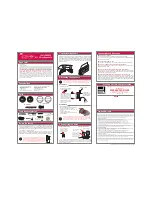
10
SUBWOOFER CONNECTION
SAFETY PRECAUTION:
Before proceeding with this section be sure to read and
follow all safety precaution instruction notices at the beginning of this manual.
Turn all components OFF before connecting the subwoofer.
Ensure subwoofer is installed in a location where any rear amplifier
parts (panels, heatsinks, etc.) cannot be accidentally touched.
We recommend the use of high-quality cables and connectors when hooking up your
subwoofer
(see your Dealer).
Low-Level Input
(Fig. 5)
(For use with a receiver, processor or control unit with an LFE-Out jack.)
Using an RCA-to-RCA interconnect cable connect the subwoofer using the (LFE) Right input.
SETTING SUBWOOFER CONTROLS
When setting up your subwoofer and fine tuning it with your system, use music and video
soundtracks that you know well. They should contain selections with extended bass that is
continuous and repetitive. Set any tone or equalizer controls on your receiver or preamplifier
to flat (zero) and switch any loudness controls off.
Room acoustics vary. Experiment with subwoofer placement to find the best position. Certain
subwoofer positions may cause some bass frequency cancellation—when your speakers
and subwoofer are “out-of-phase” they work against each other through the crossover region
and bass is reduced. If bass sounds “weak” or “dislocated,” change the phase according
to the instructions in point 4, on page 11. When adjusting your subwoofer, remember that
bass should not be overbearing—the subwoofer should not draw attention to itself —but
it shouldn’t be “thin” or difficult to hear, either. Use the following set-up tips to fine-tune
subwoofer bass in your listening room:
Fig. 5






































